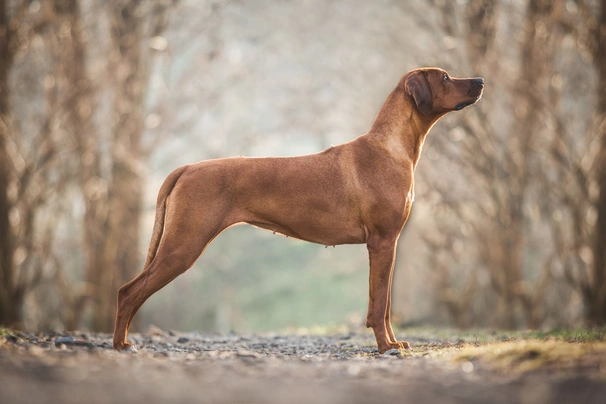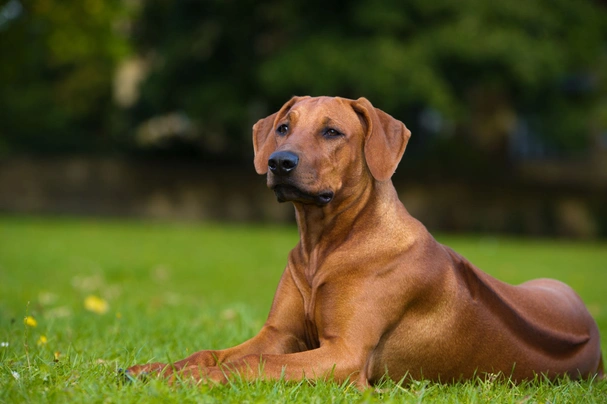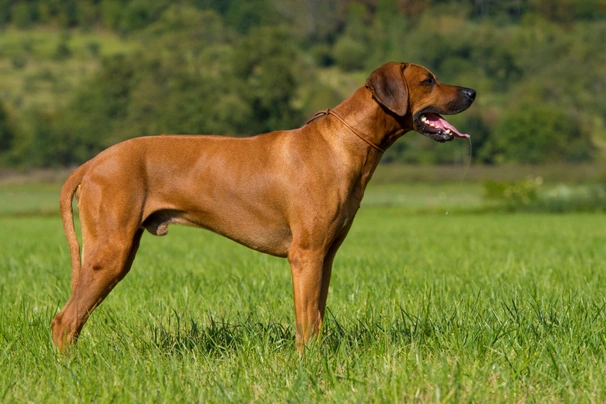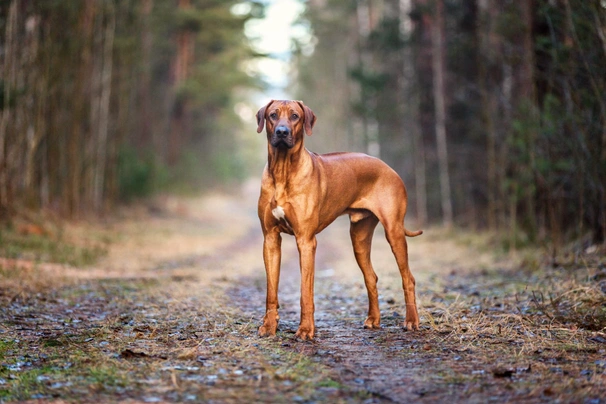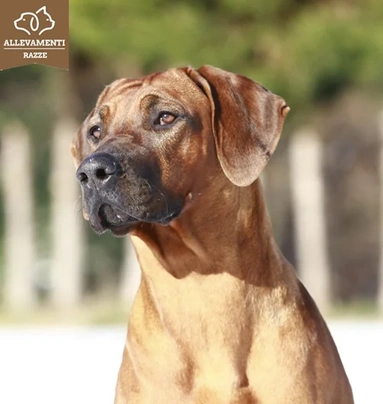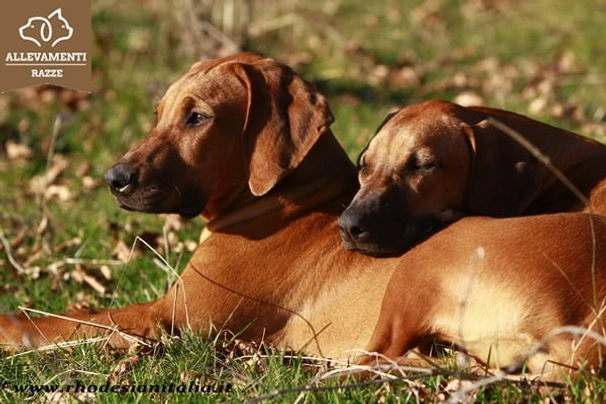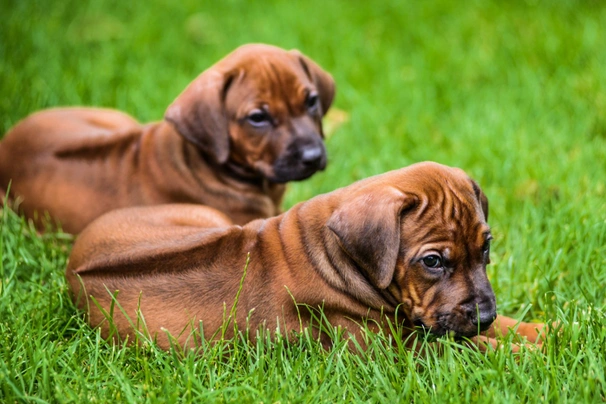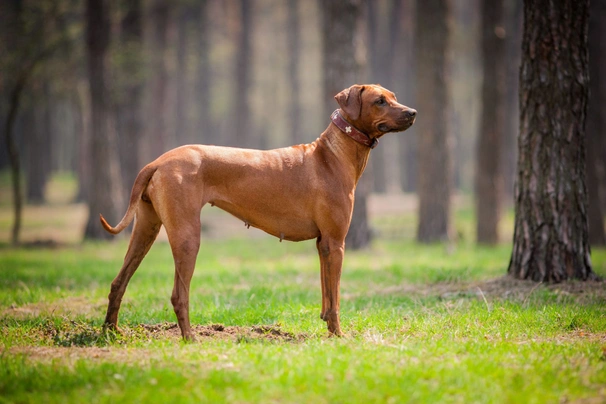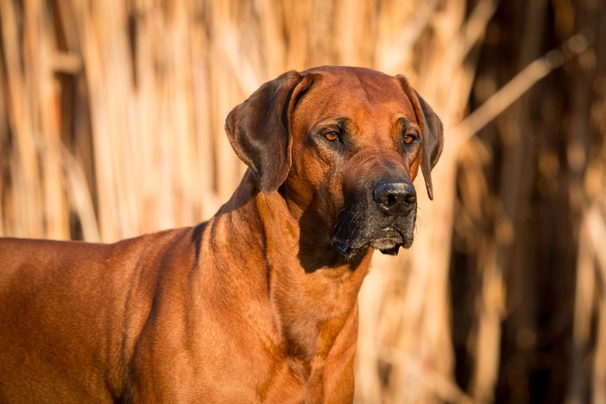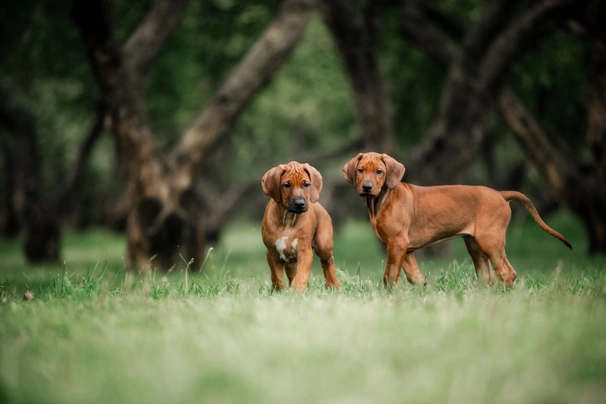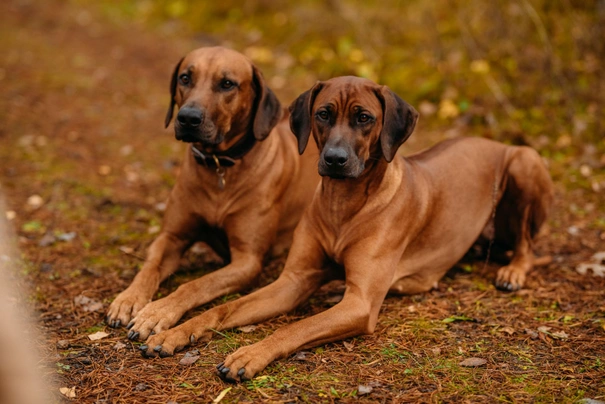Rhodesian Ridgeback
Pros
Cons
Introduction of the Rhodesian Ridgeback
The Rhodesian Ridgeback is a very distinct looking dog with their ridge down their backs. They are highly prized in their native Zimbabwe for being superb watchdogs but over the years these handsome dogs have become popular in other parts of the world including here in the UK thanks to their striking looks and loyal kind natures. The Rhodesian Ridgeback or African Lion Dog is among one of the most popular hound breeds in the UK and for good reason because they make wonderful family pets and loyal companions to share a home with the added bonus being they are known to be good around children.
History of the Rhodesian Ridgeback
It was during the 16th and 17th Centuries that Dutch and German settlers travelled from Europe to South Africa and they took a variety of dogs with them which included Great Danes Mastiffs Greyhounds Salukis and Bloodhounds. Over time these dogs were crossed with the native Hottentot 'ridged' dog and their offspring were the forefathers of the modern Rhodesian Ridgeback.
Ridgebacks were bred to be tough with enough courage to hunt down lions and to protect owners in the harsh bushland terrains of Rhodesia. They inherited the distinctive ridge down their backs from the native Hottentot dog. The story has it that a missionary in the late 1800's loaned two dogs to a big game hunter in Rhodesia (now Zimbabwe) and the hunter was so impressed with the dogs that he decided to breed a pack of Ridgebacks of his own. It was not long before the Ridgeback became the dog of choice for lion hunters throughout the land thanks to their courage and bravery on hunting expeditions. Pretty soon their fame spread throughout the world. The first Ridgeback club was formed in Africa in 1922 when a breed standard was drawn up which remain to this day.
Today Ridgebacks are a popular choice as both companion dogs and family pets not only here in the UK but elsewhere in the world thanks to their handsome looks and loyal kind natures.
Interesting facts about the breed
- Is the Rhodesian Ridgeback a vulnerable breed? No the among some of the most popular breeds in the UK and elsewhere in the world being ranked 87 out of 238 breeds on the Pets4homes website
- Ridgebacks are also known as "African Lion Hounds"
- Not all pure-bred Ridgebacks have a "ridge" down their backs
- Ridgebacks although wonderful watchdogs are not known to be "barkers"
- Rhodesian Ridgebacks are known to like their food a little too much and will eat themselves "sick" if they can
- They were bred to hunt lions and large game in packs in their native South Africa
Appearance of the Rhodesian Ridgeback
Height at the withers: Males 63 - 69 cm Females 61 - 66 cm
Average weight: Males 36 kg Females 32 kg
The Rhodesian Ridgeback is a handsome large dog that boasts a lot of presence. They are powerful and strong with the now famous ridge that runs the full length of a dog’s back. Their heads are quite long and broad between the ears with a stop that's nicely defined. A dog's nose can either be black or brown to match the colour of a dog's coat and their eyes can be dark or amber. Their muzzles are long powerful and deep and their eyes being set nicely apart and round shaped with dogs having a bright alert and intelligent expression in them.
Their ears are set high on a dog's head and moderately large being wider at the base and they gently taper to a round point at the tip. Dogs carry their ears close to their heads. The Rhodesian Ridgeback has a strong jaw with a perfect scissor bite where their upper teeth neatly overlap their lower ones with dog having well developed canines. Their necks are quite long and strong with nicely sloping shoulders. Front legs are straight well boned and strong.
Their chests are very deep but not too wide with ribs being well sprung. The Ridgeback has a very powerful strong back and their loins are muscular and nicely arched. Their hindquarters are powerful with dogs having well developed back legs. Their feet are compact with well arched toes and hair in between both their toes and their paw pads. Tails are stronger at the base but taper gently towards the tip which dog carry slightly curved.
When it comes to their coat the Rhodesian Ridgeback has a short dense and very sleek coat with a nice natural sheen to it. The accepted breed colours for Kennel Club registration are as follows:
- Light Wheaten
- Red Wheaten
- Wheaten
Dogs can have dark muzzles and ears which allowed under the breed standard.
Gait/movement
When a Rhodesian Ridgeback moves they do so with a straight free-moving and forward action covering a lot of ground when they do.
Faults
The Kennel Club frowns on any exaggerations or departures from the breed standard and would judge the faults on how much they affect a dog's overall health and wellbeing as well as their ability to perform.
Males should have both testicles fully descended into their scrotums and it is worth noting that a dog can be a little lighter or heavier as well as slightly taller or shorter than set out in the Kennel Club breed standard which is given as a guideline only.
Temperament of the Rhodesian Ridgeback
Known to be extremely courageous the Rhodesian Ridgeback is an impressive dog that boast being powerful in body and mind. They are intelligent but boast having a bit of a stubborn streak in them which in short means they need to be handled and trained by someone who is familiar with the breed or this type of intelligent strong willed dog. They form strong bonds with their families and make exceptionally good watchdogs because they are naturally wary of people they don't know. However a Ridgeback would not show any sort of aggression towards a stranger preferring to just keep their distance and let an owner know there is somebody about.
These powerful dogs need to be well socialised from a young enough age for them to mature into more confident and relaxed adult dogs. They are good around children although because of their size and their playful boisterous natures they are a better suited to families where the children are slightly older and who therefore know how to behave around a dog.
Ridgebacks respect a calm and confident leader and react accordingly during their training. They are intelligent and have no trouble learning new things providing their training starts early. It must be consistent and fair so a dog understands what is expected of them. These dogs need to know their place in the pack and who is the alpha dog in a household or they may start to show a more dominant and unruly side to their nature.
Are they a good choice for first time owners?
Rhodesian Ridgebacks are not the best choice for first time dog owners because they need to be handled and trained by people who are familiar with their needs. Ridgebacks can be wilful and stubborn when the mood takes them which makes their training more challenging. It takes time understanding of the breed and patience when training these intelligent dogs and if not well enough handled from the word go a Ridgeback might get the better of an inexperienced owner.
What about prey drive?
Rhodesian Ridgebacks have an extremely high prey drive which is a trait that is deeply embedded in a dog's psyche. As such great care should always be taken when a Ridgeback meets other animals and pets. It is also worth noting that males tend to be more aggressive towards other male dogs more especially if they have not been neutered.
What about playfulness?
Ridgebacks have a very playful side to their natures and love to entertain with puppies being extremely boisterous around the home. As such it is best to teach puppies to play outside for this very reason and to make sure that valuable ornaments and objects around the home are put away to avoid breakages.
What about adaptability?
The Rhodesian Ridgeback is better suited to people who live in houses with very secure back gardens rather than people who live in apartments. The reason being that they require a lot of vigorous daily exercise combined with a ton of mental stimulation to be truly happy well-balanced dogs.
What about separation anxiety?
Although Ridgebacks form strong ties with their families it is possible to teach them that being on their own is not a stressful experience although this should never be for too long. Any dog that's left to their own devices for extended periods of time could develop behavioural issues which includes being destructive around the home bearing in mind that Ridgebacks have a low boredom threshold and will quickly find new ways to amuse themselves often with disastrous results.
What about excessive barking?
The Rhodesian Ridgeback is not known to be a "barker" even though they are excellent watchdogs. As such excessive barking is not a problem commonly associated with the breed. With this said any dog that’s left alone for too long may start barking to get someone’s attention.
Do Rhodesian Ridgebacks like water?
Most Ridgebacks love swimming and will take to the water whenever they can more especially when the weather is hot. However if anyone who owns a dog that does not like water should never force them to go in because it would just end up scaring them. With this said care should always be taken when walking a Ridgeback off the lead anywhere near more dangerous watercourses just in case a dog decides to leap in and then needs rescuing because they can't get out of the water on their own.
Are Rhodesian Ridgebacks good watchdogs?
The Rhodesian Ridgeback is a natural watchdog and extremely protective of their owners and property. As such they do not need to be "trained" to guard which could make a dog more dominant and aggressive. With this said Ridgebacks are not known to be "barkers" preferring to put themselves in-between anything they perceive as a threat and their owners as a way of protecting them.
Intelligence / Trainability of the Rhodesian Ridgeback
Although highly intelligent the Ridgeback is a strong willed and often stubborn dog to train. However if their socialisation and training starts early enough in the right environment and with the correct amount of training these dogs can be a real pleasure to have around. The key to successfully training a Ridgeback is to use positive reinforcement and to show a dog a lot of patience and understanding during a training session. It would be a mistake to try to rush things with a young Ridgeback but rather to take the time to guide them gently into learning how to behave.
Making their training as diverse and interesting as possible helps keep a Ridgeback focused and the more they enjoy the one-to-one attention they are given the better they respond to a command. They do not respond well to any sort of harsh correction which would not achieve any sort of good results and may even harm a Ridgeback's confidence. Providing their training is consistent throughout their lives these handsome dogs will always do their best to please an owner.
Ridgeback puppies are incredibly cute and they are also very boisterous which means playtime can be a little overwhelming at times. New owners need to start out as they mean to go on which means laying down rules and boundaries right from the word go so that puppies understand what sort of behaviour is acceptable and which is not. All dogs should be taught their place in the "pack" and who is the alpha dog in a household bearing in mind that Ridgeback puppy will always test boundaries from time to time just for the fun of it and to see how much they can get away with. The first commands a puppy should be taught are as follows:
- Come
- Sit
- Stay
- Quiet
- Leave it
- Down
- Bed
Children and other
Ridgebacks are known to be good around children thanks to their placid natures in a home environment. They love being part of a family and being involved in everything that goes on in a household. However they are a better choice for families where the children are slightly older and who therefore know how to behave around a dog. With this said any interaction between a toddler or young child and a Ridgeback should always be supervised by an adult to make sure things stay nice and calm.
If well socialised from a young age Ridgebacks generally get on well with other dogs and rarely would one of them show any sort of aggressive behaviour when they first meet another dog. However care must be taken when they are around cats and smaller pets because of their high prey drive. With this said if a Ridgeback grows up with a cat in a household they generally get on well together.
Health of the Rhodesian Ridgeback
The average life expectancy of a Rhodesian Ridgeback is between 9 and 15 years when properly cared for and fed an appropriate good quality diet to suit their ages.
Like so many other breeds the Ridgeback is known to suffer from a few hereditary health issues which are worth knowing about if you are planning share your home with one of these energetic intelligent dogs. The conditions that seem to affect the breed the most include the following:
- Hip dysplasia - breeders should have their stud dogs hip scored
- Elbow dysplasia - breeders should have stud dogs tested
- Canine epilepsy
- Hypothyroidism
- Dermoid Sinus - Breeder should have puppies tested
- Juvenile Myclonic Epilepsy (JME)
- Congenital deafness - a BAER test is available through the Animal Health Trust (AHT)
- Bloat/gastric torsion - a serious condition that needs immediate veterinary attention
More about Dermoid Sinus
The Rhodesian Ridgeback is predisposed to suffering from a genetic skin disorder called Dermoid Sinus. Puppies are born with the condition and if the problem is serious it can result in abscesses forming on a dog's skin which are extremely painful and could even be life threatening. The problem typically affects the areas around a dog's neck at the midline and along a dog's spinal column namely along the back and tail.
Dermoid Sinus is a congenital disorder and affected puppies can undergo surgery to remove the Sinus before being rehomed to new owners. Affected puppies even when they have undergone the surgery should not be used for breeding purposes and puppies should be examined by at least 2 experienced breeders before being sold to prospective owners.
More about Juvenile Myclonic Epilepsy (JME)
It has now been established that Juvenile Myclonic Epilepsy or JME is an inherited condition that only affects the Rhodesian Ridgeback. Puppies need to inherit 2 copies of the defective gene one from each parent to inherit the disorder which means the mode of inheritance is what is referred to as being "recessive". With this said a Ridgeback can be a "carrier" having inherited just one copy of the defective gene. Fortunately there is now a test available through Laboklin and all breeders should have their stud dogs tested before they use them for breeding purposes.
What about vaccinations?
Ridgeback puppies would have been given their initial vaccinations before being sold but it is up to their new owners to make sure they have their follow-up shots in a timely manner with the vaccination schedule for puppies being as follows:
- 10 -12 weeks old bearing in mind that a puppy would not have full protection straight away but would be fully protected 2 weeks after they have had their second vaccination
There has been a lot of discussion about the need for dogs to have boosters. As such it's best to talk to a vet before making a final decision on whether a dog should continue to have annual vaccinations which are known as boosters.
What about spaying and neutering?
A lot of vets these days recommend waiting until dogs are slightly older before spaying and neutering them which means they are more mature before undergoing the procedures. As such they advise neutering males and spaying females when they are between the ages of 6 to 9 months old and sometimes even when a dog is 12 months old.
Other vets recommend spaying and neutering dogs when they are 6 months old but never any earlier unless for medical reasons. With this said many breeds are different and it is always advisable to discuss things with a vet and then follow their advice on when a dog should be spayed or neutered.
What about obesity problems?
Some Ridgebacks gain weight after they have been spayed or neutered and it's important to keep an eye on a dog's waistline just in case they do. If a dog starts to put on weight it's important to adjust their daily calorie intake and to up the amount of exercise they are given bearing in mind that a Ridgeback will eat for the sake of it and will make themselves very sick when they do. Older Ridgebacks too are more prone to gaining weight and again it's essential they be fed and exercised accordingly because obesity can shorten a dog's life by several years. The reason being that it puts a lot of extra strain on a dog's internal organs including the heart which could prove fatal.
What about allergies?
Some Ridgebacks are prone to suffering from allergies and it's important for a dog to see a vet sooner rather than later if one flares up bearing in mind that puppies can inherit a skin disorder known as Dermoid Sinus. Allergies can be notoriously hard to clear up and finding the triggers can be challenging. With this said a vet would be able to make a dog with an allergy more comfortable while they try to find out the triggers which could include the following:
- Certain foods that contain high volumes of grain and other cereal fillers
- Airborne pollens
- Dust mites
- Environment
- Flea and tick bites
- Chemicals found in everyday household cleaning products
Participating in health schemes
All responsible Rhodesian Ridgeback breeders would ensure that their stud dogs are tested for known hereditary and congenital health issues known to affect the breed by using the following schemes:
- Breed Club - Dermoid sinus check (puppies)
- BVA/KC Hip Dysplasia Scheme
- BVA/KC Elbow Dysplasia Scheme
- Juvenile Myclonic Epilepsy (JME) - test available through Laboklin
- BAER test for congenital deafness through the Animal Health Trust (AHT)
What about breed specific breeding restrictions?
Apart from the standard breeding restrictions set in place for all Kennel Club registered breeds there are no other breed specific breeding restrictions in place for the Rhodesian Ridgeback.
What about Assured Breeder Requirements?
It is mandatory for all KC Assured Breeders to have stud dogs tested for health concerns known to affect the breed using the following scheme and the Kennel Club strongly recommends that other breeders also follow suit:
- BVA/KC Hip Dysplasia Scheme
- The Kennel Club also strongly advises all breeders use the following schemes:
- Breed Club - Dermoid sinus check (puppies)
- Bitches under the age of 2 years should not produce a litter
- Bitches should not produce more than 3 litters in their lifetime
- Bitches should not produce more than one litter in a 12-month period
Caring for the Rhodesian Ridgeback
As with any other breed Ridgebacks need to be groomed on a regular basis to make sure their coats and skin are kept in top condition. They also need to be given regular daily exercise to ensure they remain fit and healthy. On top of this dogs need to be fed good quality food that meets all their nutritional needs throughout their lives.
Caring for a Rhodesian Ridgeback puppy
Ridgeback puppies are boisterous and full of life which means it's essential for homes and gardens to be puppy-proofed well in advance of their arrival. A responsible breeder would have well socialised their puppies which always leads to more outgoing confident and friendly dogs right from the word go. With this said any puppy is going to feel vulnerable when they leave their mother and littermates which must be taken into account. The longer a puppy can remain with their mother the better although it should never be for too long either.
It's best to pick a puppy up when people are going to be around for the first week or so which is the time needed for a puppy to settle in. Puppy-proofing the home and garden means putting away any tools and other implements that a boisterous puppy might injure themselves on. Electric wires and cables must be put out of their reach because puppies love chewing on things. Toxic plants should be removed from flowerbeds and the home too.
Puppies need to sleep a lot to grow and develop as they should which means setting up a quiet area that's not too out of the way means they can retreat to it when they want to nap and it's important not to disturb them when they are sleeping. It's also a good idea to keep "playtime" nice and calm inside the house and to have a more active "playtime" outside in the garden which means puppies quickly learn to be less boisterous when they are inside.
The documentation a breeder provides for a puppy must have all the details of their worming date and the product used as well as the information relating to their microchip. It is essential for puppies to be wormed again keeping to a schedule which is as follows:
- Puppies should be wormed at 6 months old
- They need to be wormed again when they are 8 months old
- Puppies should be wormed when they are 10 months old
- They need to be wormed when they are 12 months old
Things you'll need for your puppy
There are certain items that new owners need to already have in the home prior to bringing a new puppy home. It's often a good idea to restrict how much space a puppy plays in more especially when you can't keep an eye on what they get up to bearing in mind that puppies are often quite boisterous which means investing in puppy gates or a large enough playpen that allows a puppy the room to express themselves while keeping them safe too. The items needed are therefore as follows:
- Good quality puppy or baby gates to fit on doors
- A good well-made playpen that's large enough for a puppy to play in so they can really express themselves as puppies like to do
- Lots of well-made toys which must include good quality chews suitable for puppies to gnaw on bearing in mind that a puppy will start teething anything from when they are 3 to 8 months old
- Good quality feed and water bowls which ideally should be ceramic rather than plastic or metal
- A grooming glove
- A slicker brush or soft bristle brush
- Dog specific toothpaste and a toothbrush
- Scissors with rounded ends
- Nail clippers
- Puppy shampoo and conditioner which must be specifically formulated for use on dogs
- A well-made dog collar or harness
- A couple of strong dog leads
- A well-made dog bed that's not too small or too big
- A well-made dog crate for use in the car and in the home that's large enough for a puppy to move around in
- Baby blankets to put in your puppy's crate and in their beds for when they want to nap or go to sleep at night
Keeping the noise down
All puppies are sensitive to noise including Rhodesian Ridgeback puppies. It's important to keep the noise levels down when a new puppy arrives in the home. TVs and music should not be played too loud which could end up stressing a small puppy out.
Keeping vet appointments
As previously mentioned Ridgeback puppies would have been given their first vaccinations by the breeders but they must have their follow up shots which is up to their new owners to organise. The vaccination schedule for puppies is as follows:
- 10 -12 weeks old bearing in mind that a puppy would not have full protection straight away but would only be fully protected 2 weeks after they have had their second vaccination
When it comes to boosters it's best to discuss these with a vet because there is a lot of debate about whether a dog really needs them after a certain time. However if a dog ever needed to go into kennels their vaccinations would need to be
What about older Rhodesian Ridgebacks when they reach their senior years?
Older Ridgebacks need lots of special care because as they reach their golden years they are more at risk of developing certain health concerns. Physically a dog's muzzle may start to go grey but there will be other noticeable changes too which includes the following:
- Coats become coarser
- A loss of muscle tone
- Ridgebacks can either become overweight or underweight
- They have reduced strength and stamina
- Older dogs have difficulty regulating their body temperature
- They often develop arthritis
- Immune systems do not work as efficiently as they once did which means dogs are more susceptible to infections
Older dogs change mentally too which means their response time tends to be slower as such they develop the following:
- They respond less to external stimuli due to impaired vision or hearing
- They tend to be a little pickier about their food
- They have a lower pain threshold
- Become intolerant of any change
- Often an older dog can feel disorientated
Living with a Rhodesian Ridgeback in their golden years means taking on a few more responsibilities but these are easily managed and should include looking at their diet the amount of exercise they are given how often their dog beds need changing and keeping an eye on the condition of their teeth.
Older Ridgebacks need to be fed a good quality diet that meets their needs at this stage of their lives all the while keeping a close eye on a dog's weight. A rough feeding guide for older dogs is as follows bearing in mind they should be fed highly digestible food that does not contain any additives:
- Protein content should be anything from 14 – 21%
- Fat content should be less than 10%
- Fibre content should be less than 4%
- Calcium content should be 0.5 – 0.8%
- Phosphorous content should be 0.4 – 0.7%
- Sodium content should be 0.2 – 0.4%
Older Ridgebacks don't need to be given the same amount of daily exercise as a younger dog but they still need the right amount of physical activity to maintain muscle tone and to prevent a dog from putting on too much weight. All dogs need access to fresh clean water and this is especially true of older dogs when they reach their golden years because they are more at risk of developing kidney disorders.
Grooming of the Rhodesian Ridgeback
Ridgebacks boasts short close and quite glossy coats which means they are low maintenance in the grooming department. A weekly brush and a wipe over with a chamois leather every couple of days is all it takes to keep their coats looking good. They do shed throughout the year only more so during the Spring and then again in the Autumn when more frequent brushing is usually needed to get rid of any dead and loose hair in a dog's coat.
It's also important to check a dog's ears on a regular basis and to clean them when necessary. If too much wax builds up in a dog's ears it can lead to a painful infection which can be hard to clear up. In short prevention is often easier than cure when it comes to ear infections.
Exercise of the Rhodesian Ridgeback
Ridgebacks are high energy intelligent dogs and as such they need to be given the right amount of daily exercise and mental stimulation for them to be truly happy well-balanced and obedient dogs. They need a minimum of 2 hour's vigorous exercise every day and this must be combined with a ton of mental stimulation.
A shorter walk in the morning would be fine but a longer more interesting one in the afternoon is a must. These dogs also like to be able to roam around a back garden as often as possible so they can really let off steam. However the fencing must be extremely secure to keep these high energy dogs in because if they find a weakness in the fence they will soon escape out and get into all sorts of trouble. However care should be taken when walking a Ridgeback in the country or in the park because of their high prey drive. As such letting a dog off their lead should be in a secure and safe area.
With this said Ridgeback puppies should not be over exercised because their joints and bones are still growing. This includes not letting a dog jump up and down from furniture or going up or down the stairs. Too much pressure placed on their joints and spines at an early age could result in a dog developing problems later in their lives. Ridgeback puppies and young dogs are extremely boisterous and need to be well supervised during playtime more especially when children are around. Anything of value also needs to be put away to avoid breakages.
Feeding of the Rhodesian Ridgeback
If you get a Ridgeback puppy from a breeder they would give you a feeding schedule and it's important to stick to the same routine feeding the same puppy food to avoid any tummy upsets. You can change a puppy's diet but this needs to be done very gradually always making sure they don't develop any digestive upsets and if they do it's best to put them back on their original diet and to discuss things with the vet before attempting to change it again.
Older dogs are not known to be fussy or finicky eaters but this does not mean you can feed them a lower quality diet. It's best to feed a mature dog twice a day once in the morning and then again in the evening making sure it's good quality food that meets all their nutritional requirements. It's also important that dogs be given the right amount of exercise so they burn off any excess calories or they might gain too much weight which can lead to all sorts of health issues. Obesity can shorten a dog's life by several years so it's important to keep an eye on their waistline from the word go.
Because Ridgebacks are prone to suffer from bloat it is important that they be fed twice a day instead of giving them just one larger meal a day. It's also a good idea to invest in a stand to place their feed bowl which makes it easier for these large dogs to eat comfortably without having to stretch their necks down low to reach their food. Dogs should never be exercised just before or just after they have eaten either because this puts them more at risk of suffering from bloat.
Feeding guide for a Rhodesian Ridgeback puppy
Puppies need to be fed a highly nutritious good quality diet for them to develop and grow as they should. As a rough guide a Ridgeback puppy can be fed the following amounts every day making sure their meals are evenly spread out throughout the day and it's best to feed them 3 or 4 times a day:
- 2 months old - 274g to 286g depending on puppy's build
- 3 months old - 344g to 365g depending on puppy's build
- 4 months old - 374g to 400g depending on puppy's build
- 5 months old - 413g to 454g depending on puppy's build
- 6 months old - 450g to 505g depending on puppy's build
- 7 months old - 450g to 506g depending on puppy's build
- 8 months old - 419g to 471g depending on puppy's build
- 9 months old - 391g to 440g depending on puppy's build
- 10 months old - 356g to 402g depending on puppy's build
- 11 months old - 323g to 365g depending on puppy's build
- 12 months old - 321g to 363g depending on puppy's build
- 13 months old - 320g to 360g depending on puppy's build
- 14 months old - 318g to 357g depending on puppy's build
Once a puppy is 15 months old they can be fed adult dog food.
Feeding guide for an adult Rhodesian Ridgeback
Once fully mature an adult Ridgeback must be fed a good quality diet to ensure their continued good health. As a rough guide an adult Rhodesian Ridgeback can be fed the following amounts every day:
- Dogs weighing 32 kg can be fed 322g to 424g depending on activity
- Dogs weighing 36 kg can be fed 352g to 463g depending on activity
Rhodesian Ridgeback price
If you are looking to buy a Rhodesian Ridgeback you would need to pay anything from £150 to over £1000 for a well-bred pedigree puppy. The cost of insuring a male 3-year-old Ridgeback in northern England would be £56.39 a month for basic cover but for a lifetime policy this would set you back £74.76 a month (quote as of November 2017). When insurance companies calculate a pet's premium they factor in several things which includes where you live in the UK a dog's age and whether they have been neutered or spayed among other things.
When it comes to food costs you need to buy the best quality food whether wet or dry to feed your dog making sure it suits the different stages of their lives. This would set you back between £40 - £50 a month. On top of this you would need to factor in veterinary costs if you want to share your home with a Ridgeback and this includes their initial vaccinations their annual boosters the cost of neutering or spaying a dog when the time is right and their yearly health checks all of which quickly adds up to over £1000 a year.
As a rough guide the average cost to keep and care for a Rhodesian Ridgeback would be between £100 to £130 a month depending on the level of insurance cover you opt to buy for your dog but this does not include the initial cost of buying a well-bred healthy Kennel Club registered Rhodesian Ridgeback puppy.
Buying advice
When visiting and buying any puppy or dog there are many important things to consider and questions to ask of the breeder/seller. You can read our generic puppy/dog advice here which includes making sure you see the puppy with its mother and to verify that the dog has been wormed and microchipped.
Rhodesian Ridgebacks are one of the more popular breeds both in the UK and elsewhere in the world which means that well-bred puppies command a lot of money. As such with Ridgebacks there is specific advice questions and protocols to follow when buying a puppy which are as follows:
- Beware of online scams and how to avoid them. You may see online and other adverts by scammers showing images of beautiful Ridgeback puppies for sale at very low prices. However the sellers ask buyers for money up front before agreeing to deliver a puppy to a new home. Potential buyers should never buy a puppy unseen and should never pay a deposit or any other money online to a seller. You should always visit the pet at the sellers home to confirm they are genuine and make a note of their address.
- As previously touched upon Ridgebacks are among the most popular breeds in the UK. As such there are many amateur breeders/people who breed from dam far too often so they can make a quick profit without caring for the welfare of the puppies their dam or the breed in general. Under Kennel Club rules a dam can only produce 4 litters and she must be between a certain age to do so. Anyone wishing to buy a Rhodesian Ridgeback puppy should think very carefully about who they purchase their puppy from and should always ask to see the relevant paperwork pertaining to a puppy's lineage their vaccinations and their microchipping.
- Prospective Ridgeback owners should be aware that puppies are predisposed to a congenital skin disorder known as Dermoid Sinus and that all Rhodesian Ridgeback puppies should be examined by at least 2 experienced breeders before being sold to establish they have not inherited the disorder.
